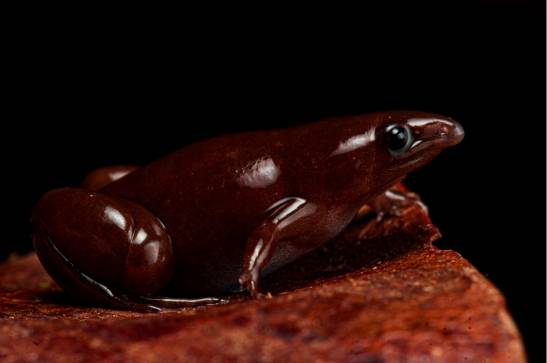The inhabitants of the Três Esquinas Indigenous Community, in the Peruvian Amazon, have long known a small burrowing frog with a long snout, which they named after the elongated shape of its nose, tapir frogname by which it is also known tapir Mesoamerican, a large land mammal.
Being so elusive, biologists have not been able to find these frogs until now, when guided by local guides, they finally discovered them in the Putomayo basin in Peruvian Amazon. “These frogs are really hard to find, and that makes them understudied,” he says. michelle thompsonresearcher at the Keller Center for Scientific Action at the Field Museum in Chicago, USA and co-author of the study published in the journal Evolutionary Systematics.
Although they are distributed throughout the Amazon, these amphibians, called Tapir Synapturanus, they live underground and their distribution areas are very limited as they do not move much during excavation. Indeed, in the case of this new species, found in the nutrient-rich acidic wetlands of the Amazon, made of decaying plant matter known as peat bogsscientists believe it may be restricted to that environment.
“The body shape and overall appearance seem to be adapted to the soft bog soil, rather than the wider, stockier shape of species in other environments,” he says. German Chavezresearcher of Peruvian Institute of Herpetology and first author of the work.
One of the specimens found in Peru. / German Chavez
This is the new species, small, elusive and noisy
The appearance of the tapir surprised scientists: “It looks like a caricature of a tapirbecause it has a big bulky body with a little pointed head” describes Thompson. Despite being remarkable, it was very difficult to find due to its small size –no larger than a quarter– and its brownish color that merged with the earth.
“They’re underground and they’re fast. You know they’re somewhere below, but you don’t see them jumping around,” says the expert. But although they are hard to see, they can be heard. While looking for specimens in the peat bogs, the team heard a whistle coming from underground and waited for the night, when the amphibians are most active, to find them.
Thanks to frog specimens, recordings of their songs and DNA analysis, biologists were able to confirm that it was a new species.
“We had already picked up a young man on our first night in the swamps, but by 2 or 3 in the morning we were tired. We decided to go back to that place our last night, after three searching for frogs and snakes, to go find those frogs that we had heard at the beginning”, recalls Chávez.
After several hours of digging and chasing the beeping calls – which were recorded during the search – that night they finally managed to capture another specimen, this time an adult. Thanks to frog specimens, recordings of their songs and a DNA analysisbiologists were able to confirm that it was a new species.
“Our genetic analyzes show that this new species belongs to a group that evolved in western Amazonia, where the influence of prehistoric landscapes such as Lake Pebas may have created different wetlands, which gave rise to the diversity what we see in sinapturane nowadays,” explains Chávez.
when you need dens hide, peat bogs have become a habitat perfect for these animals: “They are part of the underground ecosystem. They move around, eat and lay their eggs down there. They contribute to the nutrient cycle and to alter the structure of the soil”, says Thompson, for whom frogs can also be an indicator of the health of these ecosystems in a region that needs to be conserved.
The discovery of this amphibian demonstrates the need for scientists and locals to work together to protect this region. “It is an example of the hidden diversity of the amazonand it is important to document to understand the importance of the functioning of this ecosystem”, concludes the researcher.
Juvenile tapir frog. / German Chavez
Reference:
German Chavez et al. “A needle in a haystack: integrative taxonomy reveals the existence of a new small species of fossorial frog (Anura, Microhylidae, Synapturanus) from the vast lower basin of the Putumayo, Peru” Evolutionary Systematics
